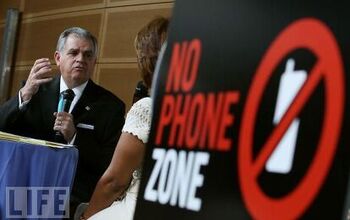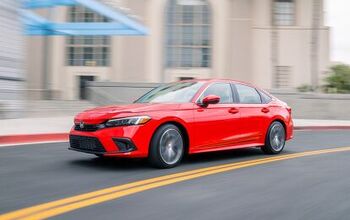LaHood Launches Spring Offensive In War On Distracted Driving
Thus far, Transportation Secretary Ray LaHood’s war on distracted driving has been largely a rhetorical hobbyhorse, giving the good Secretary a crowd-pleasing speech topic no matter where he finds himself. After calling the situation “an epidemic,” LaHood held a summit at which it was agreed that distracted driving is bad, especially when it causes deaths. Federal employees were subsequently barred from texting while driving government-owned vehicles during work hours. And that was just about it. Apparently chastened by his big build-up and lack of pay-off on this issue, LaHood has kept himself busy with the Toyota debacle of late, leaving distracted driving largely alone since last summer’s summit. Until he remembered that there was one crucial tool in his bureaucratic bag of tricks that he hadn’t yet used: the photo op.
LaHood spent $400,000 out of his budget to support pilot programs in Hartford, CT and Syracuse, NY aimed at “highly visible enforcement” of state laws against cell phone use while driving. The program is modeled on the DOT’s “click it or ticket” campaign which sought to raise awareness as well as enforcement of state seatbelt laws. LaHood explains on his Fastlane blog:
through all of my work to reduce this deadly epidemic, I have noticed one constant point of resistance: people asking, “What’s the point of these laws? It’s not like we can enforce them.”
Today, in Hartford and Syracuse we begin testing the idea that enforcement can change behavior by applying the lessons we learned when people raised the same criticism of seat belt laws or drunk driving laws.
The idea is to test tactics that could be used on a wider basis, but more realistically, it’s just another way to raise awareness. As LaHood puts it:
Look, distracted driving is not just a technology problem; it’s a human problem. And only by changing human behavior can we make our roads safer from this threat.
Together, I know we can do that.
And by “together” he means, with help from Oprah. Ironically, LaHood’s nearly half-million dollar campaign probably won’t “change human behavior” with half the success of a single Oprah show.
More by Edward Niedermeyer
Latest Car Reviews
Read moreLatest Product Reviews
Read moreRecent Comments
- HotRod Not me personally, but yes - lower prices will dramatically increase the EV's appeal.
- Slavuta "the price isn’t terrible by current EV standards, starting at $47,200"Not terrible for a new Toyota model. But for a Vietnamese no-name, this is terrible.
- Slavuta This is catch22 for me. I would take RAV4 for the powertrain alone. And I wouldn't take it for the same thing. Engines have history of issues and transmission shifts like glass. So, the advantage over hard-working 1.5 is lost.My answer is simple - CX5. This is Japan built, excellent car which has only one shortage - the trunk space.
- Slavuta "Toyota engineers have told us that they intentionally build their powertrains with longevity in mind"Engine is exactly the area where Toyota 4cyl engines had big issues even recently. There was no longevity of any kind. They didn't break, they just consumed so much oil that it was like fueling gasoline and feeding oil every time
- Wjtinfwb Very fortunate so far; the fleet ranges from 2002 to 2023, the most expensive car to maintain we have is our 2020 Acura MDX. One significant issue was taken care of under warranty, otherwise, 6 oil changes at the Acura dealer at $89.95 for full-synthetic and a new set of Michelin Defenders and 4-wheel alignment for 1300. No complaints. a '16 Subaru Crosstrek and '16 Focus ST have each required a new battery, the Ford's was covered under warranty, Subaru's was just under $200. 2 sets of tires on the Focus, 1 set on the Subie. That's it. The Focus has 80k on it and gets synthetic ever 5k at about $90, the Crosstrek is almost identical except I'll run it to 7500 since it's not turbocharged. My '02 V10 Excursion gets one oil change a year, I do it myself for about $30 bucks with Synthetic oil and Motorcraft filter from Wal-Mart for less than $40 bucks. Otherwise it asks for nothing and never has. My new Bronco is still under warranty and has no issues. The local Ford dealer sucks so I do it myself. 6 qts. of full syn, a Motorcraft cartridge filter from Amazon. Total cost about $55 bucks. Takes me 45 minutes. All in I spend about $400/yr. maintaining cars not including tires. The Excursion will likely need some front end work this year, I've set aside a thousand bucks for that. A lot less expensive than when our fleet was smaller but all German.


































Comments
Join the conversation
There's another problem with enforcement: the last driver to force me to engage ABS was pulling out from a stopsign looking only one direction (his right) with phone clamped to ear... in a police car. He looked furious. I suppose I'm lucky not to have been ticketed.
I have a simpler solution - mandatory jammers that activate whenever a vehicle is in Drive. If YOUR call is important enough to endanger MY life and MY health, then it's important enough to pull over and deal with. I don't want your distracted butt anywhere near me on the road. If people complain that the passenger can't call out, then we use seat weight sensors to deactivate the jammer just like airbag sensors. And expensive, punitive fines akin to DUIs for the scofflaws who deactivate the jammer.